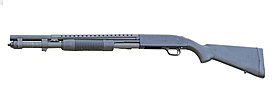
A firearm is any type of gun that uses an explosive charge and is designed to be readily carried and used by an individual. The term is legally defined further in different countries.

A shotgun is a long-barreled firearm designed to shoot a straight-walled cartridge known as a shotshell, which discharges numerous small spherical projectiles called shot, or a single solid projectile called a slug. Shotguns are most commonly used as smoothbore firearms, meaning that their gun barrels have no rifling on the inner wall, but rifled barrels for shooting sabot slugs are also available.

In firearm designs, the term single-shot refers to guns that can hold only a single round of ammunition inside and thus must be reloaded manually after every shot. Compared to multi-shot repeating firearms ("repeaters"), single-shot designs have no moving parts other than the trigger, hammer/firing pin or frizzen, and therefore do not need a sizable receiver behind the barrel to accommodate a moving action, making them far less complex and more robust than revolvers or magazine/belt-fed firearms, but also with much slower rates of fire.
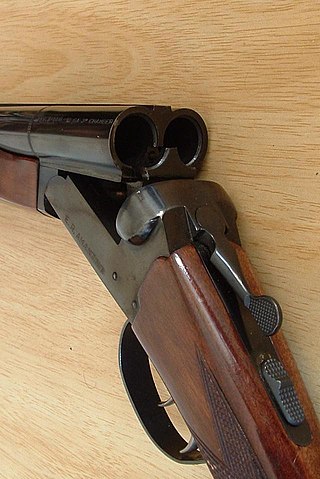
In firearms terminology, an action is the functional mechanism of a breech-loading firearm that handles the ammunition cartridges, or the method by which that mechanism works. Actions are technically not present on muzzleloaders, as all those are single-shot firearms with a closed off breech with the powder and projectile manually loaded from the muzzle. Instead, the muzzleloader ignition mechanism is referred to as the lock.

John Moses Browning was an American firearm designer who developed many varieties of military and civilian firearms, cartridges, and gun mechanisms – many of which are still in use around the world. He made his first firearm at age 13 in his father's gun shop and was awarded the first of his 128 firearm patents on October 7, 1879, at the age of 24. He is regarded as one of the most successful firearms designers of the 19th and 20th centuries and a pioneer of modern repeating, semi-automatic, and automatic firearms.
A semi-automatic firearm, also called a self-loading or autoloading firearm, is a repeating firearm whose action mechanism automatically loads a following round of cartridge into the chamber and prepares it for subsequent firing, but requires the shooter to manually actuate the trigger in order to discharge each shot. Typically, this involves the weapon's action utilizing the excess energy released during the preceding shot to unlock and move the bolt, extracting and ejecting the spent cartridge case from the chamber, re-cocking the firing mechanism, and loading a new cartridge into the firing chamber, all without input from the user. To fire again, however, the user must actively release the trigger, allow it to "reset", before pulling the trigger again to fire off the next round. As a result, each trigger pull only discharges a single round from a semi-automatic weapon, as opposed to a fully automatic weapon, which will shoot continuously as long as the ammunition is replete and the trigger is kept depressed.
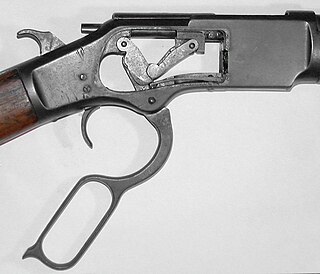
A lever action is a type of action for repeating firearms that uses a manually operated cocking handle located around the trigger guard area that pivots forward to move the bolt via internal linkages, which will feed and extract cartridges into and out of the chamber, and cock the firing pin mechanism. This contrasts to other type of repeating actions such as the bolt-action, pump-action, semi-automatic, fully automatic, and/or burst mode actions. A firearm using this operating mechanism is colloquially referred to as a levergun.
Savage Arms is an American gunmaker based in Westfield, Massachusetts, with operations in Canada and China, PRC. Savage makes a variety of rimfire and centerfire rifles, as well as Stevens single-shot rifles and shotguns. The company is best known for the Model 99 lever-action rifle, no longer in production, and the .300 Savage. Savage was a subsidiary of Vista Outdoor until 2019 when it was spun off.

The Mossberg 500 (M500) is a series of pump action shotguns manufactured by O.F. Mossberg & Sons. The 500 series comprises widely varying models of hammerless repeaters, all of which share the same basic receiver and action, but differ in bore size, barrel length, choke options, magazine capacity, stock and forearm materials. Model numbers included in the 500 series are the 500, 505, 510, 535, and 590. The Revelation 310 and the New Haven 600 were also variations of the 500 series produced by Mossberg under different names. By 2021, 11,000,000 M500s had been produced, making it the most-produced shotgun of all time.
Pump action is a type of manual firearm action that is operated by moving a sliding handguard on the gun's forestock. When shooting, the sliding forend is pulled rearward to eject any expended cartridge and typically to cock the hammer or striker, and then pushed forward to load a new cartridge into the chamber. Most pump-action firearms use an integral tubular magazine, although some do use detachable box magazines. Pump-action firearms are typically associated with shotguns, although it has been used in rifles, grenade launchers, as well as other types of firearms. A firearm using this operating mechanism is colloquially referred to as a pumpgun
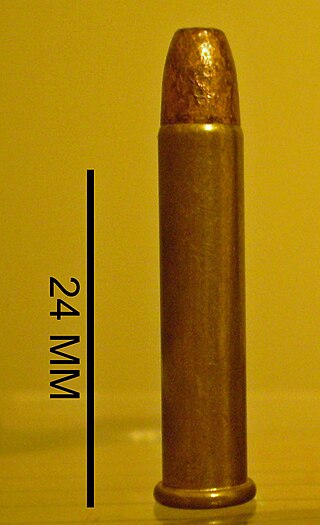
The .22 Winchester Magnum Rimfire, also called .22 WMR, .22 Magnum, .22 WMRF, .22 MRF, or .22 Mag, is a rimfire cartridge. Originally loaded with a bullet weight of 40 grains (2.6 g) delivering velocities in the 2,000 feet per second (610 m/s) range from a rifle barrel, .22 WMR is now loaded with bullet weights ranging from 50 grains (3.2 g) at 1,530 feet per second (470 m/s) to 30 grains (1.9 g) at 2,200 feet per second (670 m/s).
The Remington Model 7600 is a series of pump-action centerfire rifles made by Remington Arms. The Model 7600 is a progression from the original Model 760 pump-action rifle which Remington produced from 1952 to 1981. Production of the Model Six began in 1981 and was discontinued in 1987. Production of the Sportsman model 76 began in 1985 and was discontinued in 1987. Production of the model 7600 began in 1987 to present.

Česká zbrojovka a.s. Uherský Brod, abbreviated as CZUB or simply CZ, is a Czech armament manufacturer based in Uherský Brod, Uherské Hradiště District, Zlín Region. The company is famous for producing service, hunting and sporting firearms. It is owned by the Czech holding company Colt CZ Group SE, which also owns other brands with related production programmes.
The Winchester Repeating Arms Company was a prominent American manufacturer of repeating firearms and ammunition. The firm was established in 1866 by Oliver Winchester and was located in New Haven, Connecticut. The firm went into receivership in 1931 and was bought by the Western Cartridge Company, a forerunner of the Olin Corporation. The Winchester brand name is still owned by the Olin Corporation, which makes ammunition under that name. The Winchester name is also used under license for firearms produced by two subsidiaries of the Herstal Group – FN Herstal of Belgium and the Browning Arms Company of Ogden, Utah.
Marlin Firearms Co. is an American manufacturer of semi-automatic, lever-action, and bolt-action rifles. In the past, the company, now based in Madison, North Carolina, and formerly based in North Haven, Connecticut, made shotguns, derringers, and revolvers. Marlin owned the firearm manufacturer H&R Firearms. In 2007, Remington Arms, part of the Remington Outdoor Company, acquired Marlin Firearms. Remington produced Marlin-brand firearms at its Kentucky and New York manufacturing facilities. In 2020, Sturm, Ruger & Co. bought the Marlin business from bankrupt Remington Outdoor Company.

H&R 1871, LLC, or more commonly known as Harrington & Richardson, is an American brand of firearms and a subsidiary of JJE Capital Holdings. H&R ceased independent production February 27, 2015.
From 1908 until 1962, Sears, Roebuck & Company sold a wide variety of sporting goods and recreational equipment, including bicycles, golf clubs, rifles, shotguns, and revolvers under the brand name "J. C. Higgins." These products were well made and were popular with the company's historical core of rural and working-class consumers.
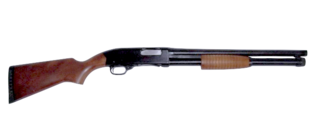
The Model 1200 is a pump-action shotgun that was manufactured by the Winchester-Western Division of Olin Corporation, starting 1964. It was redesignated the Model 1300 in 1978 with minimal changes. Production ceased in 2006 when the U.S. Repeating Arms Company, the subsequent manufacturer, went bankrupt. A militarized version of the Model 1200 was acquired by the U.S. Army for use during the Vietnam War. It is still in active service within various conflicts throughout the 21st century.














